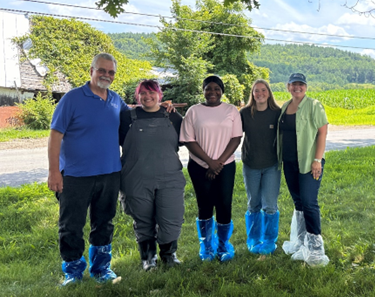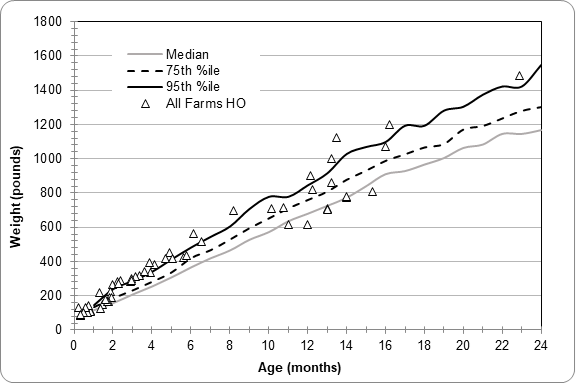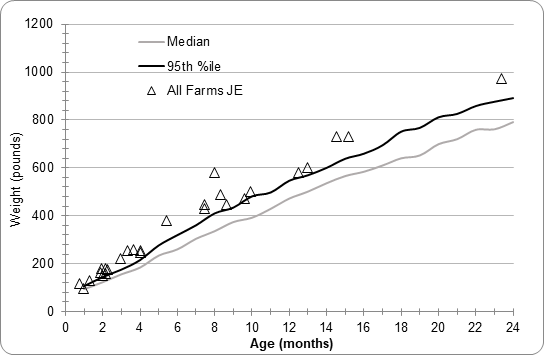By Dr. Glenda Pereira – Assistant Professor and Dairy Specialist, University of Maine.
Project collaborators: Sarah Allen, Pete Erickson, Toyin Osuolale, University of New Hampshire.
Replacement heifers remain one of the top expenses of dairy farms, and in the Northeast U.S. can cost up to $2,500. It is also anecdotally reported that many farms raise too many heifers, resulting in further costs to farmers. However, there is a lack of empirical data to support these claims or show its impact on dairy viability in the Northeast. Dairy specialists from the University of Maine and New Hampshire are collaborating on a project funded by the Northeast Dairy Business Innovation Center (NE-DBIC). Through technical assistance and education, the dairy specialists and graduate students (Figure 1) are working with New Hampshire and Maine dairy farmers to improve calf and heifer management.

From left to right, Peter Erickson, Sarah Allen, Toyin Osuolale, Lydia and Glenda Pereira.
The anticipated outcomes of this project include 1) implementing strategies to improve calf and heifer management to generate higher quality heifers, 2) calculating the expenses for raising a calf until they are a 2-year-old to estimate true cost of raising heifers in New England, 3) farmer cohort groups will work together and learn from each other, 4) project investigators will continue multi state extension programs.
The project kicked off this spring, and farmers were provided a refractometer, a thermometer, and a weigh tape, and record sheets. While the goal is to improve heifer quality, you can’t manage what you don’t measure. Therefore, we asked farmers to measure pre weaning average daily gain on their farm. Most farms are around 1.6 to 1.7 lbs per day, and most heifers are doubling their birth weight by weaning. To learn how to calculate average daily gain, visit extension.umaine.edu/publications/1078e/
Over the past few months, we also collected calf and heifer metrics (such as hip and wither height and heart girth), discussed colostrum management and conducted a sanitation audit with each individual farm. With heifer weights and heights, we were able to assess where the farm falls on the growth curve (Figure 2a,b. Holstein and Jersey bodyweight estimate growth curves). We learned that while most farms are exceeding at management, every farm has an opportunity for improvement. These growth charts also helped indicate whether the heifers were being bred at the appropriate weight. Farmers should target body weight at first conception to be 55% of mature bodyweight on their farm (cows in their 3rd or greater lactation). This ensures that the heifers are not doing a lot of growing in their first or second lactation and are also calving in at an adequate weight after first calving.

Figure 1a: Body weight of Holstein heifers (designated in the triangle) from project participant farms compared to Penn State University recommended 50th, 75th and 95th percentile benchmarks. The bodyweight measurements of heifers on participant farms were taken with a weigh tape and therefore are estimates.
The heifer growth charts indicate several percentiles of the U.S. Holstein and Jersey populations, allowing a farmer to compare an individual heifer to all others in the population. To achieve early calving (24 months or less) and high production potential, individual heifers should fall near the 95th percentile. The data is outdated and comparing to 95th allows for best representation of modern dairy calves. Source: https://extension.psu.edu/growth-monitor-compare-heifers-to-breed-standards

Figure 1b: Body weight of Jersey heifers (designated in the triangle) from project participant farms compared to Penn State University recommended 50th and 95th percentile benchmarks. The bodyweight measurements of heifers on participant farms were taken with a weigh tape and therefore are estimates.
While cleanliness is important across the entire farm, it is crucial during the newborn and pre-weaning period. Research has indicated that heifers that were impacted by diarrhea events during the pre-weaning period had 50 g/d reduction in average daily gain, required more inseminations and were associated with reduced performance in the first lactation by 716 lbs. Therefore, for our sanitation audit, we used an adenosine triphosphate (ATP) meter to swab items that are used for calf feeding (grain and milk buckets, bottles, nipples) and colostrum harvesting equipment. We learned that overall, most farmers are doing a great job with cleaning their equipment, yet some farmers were only using an alkaline detergent on some not all equipment, and the temperature of the water being used to wash these items was not optimal. While ATP meters are a great tool, farmers can use mortality rates and the Wisconsin calf health scorer to measure hygiene on their farm.
The participant farmers manage calves and heifers differently, which allows cohort group members to learn from each other. Each participating farm hosts the group on their farm, and the project investigators facilitate the meeting discussion. In July 2024, we had a cohort meeting discussion on colostrum management. Farmers learned how to build a colostrum water bath which allows for colostrum to heat up without “cooking” and denaturing important proteins. Additionally, farmers learned about the "3 Qs'' of colostrum for newborn calves' health and success as a future lactating dairy cow.
- Quantity- calves need to drink at least 10% of their body weight in colostrum to receive essential nutrients and passive immunity.
- Quality- colostrum should contain at least 50 g/L of IgG to obtain passive immunity; use of a refractometer can help assess this.
- Quickly- colostrum should be fed right away (ideally within 2 hours) to ensure absorption of IgG.
Farmers have indicated that they have already learned from project investigators and other farmers. Some farmers have even changed one or two management practices, including measuring the temperature of their colostrum thawing water, revisiting sanitation and cleaning protocols, testing colostrum quality with a refractometer, adjusting heifer rations to improve growth, and changing weaning protocols to improve calf transition.
Next steps for the project investigators include distributing a survey across New England to understand the demographics and cost of raising heifers from birth to calving. In addition, participating farmers will work with a financial consultant to calculate their own heifer costs and discuss potential risk management strategies to lower their costs. Future cohort group meeting topics include, calf and heifer rearing, nutrition, health and vaccination protocols, first lactation performance and efficiency, and economics.
To learn more about this project and other work we’re conducting, contact Glenda Pereira, NE-DBIC Cohort Lead, by email at glenda.pereira@maine.edu and by phone at 207-581-3240. View sources for this article on the NE-DBIC website at nedairyinnovation.com/improving-calf-heifer-management
Information in this article is provided purely for educational purposes. No responsibility is assumed for any problems associated with the use of products or services mentioned. No endorsement of products or companies is intended, nor is criticism of unnamed products or companies implied.

